Great Britain’s Fastest Start-to-Stop Schedule
FAMOUS TRAINS - 12
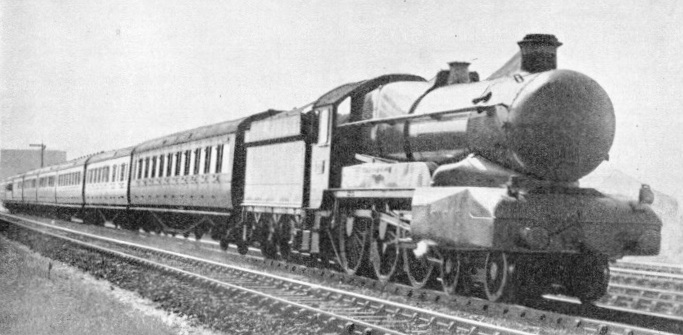
“MANORBIER CASTLE”, experimentally streamlined, hauling the “Cheltenham Flyer” near Sonning Cutting, Berks. The locomotive has four cylinders 16 in by 28 in, coupled wheels 8 ft 8½ in diameter, a total heating surface, including superheater, of 2,312 sq ft, and a boiler pressure of 225 lb. The tractive effort is 31,625 lb.
The “Cheltenham Flyer” of the Great Western Railway marks a stage in railway history. For some years this famous express held the unchallenged title to be the world’s fastest train. Even when Diesel propulsion in Germany had wrested the “blue riband” of speed from Great Britain for the fastest railway run from start to stop, the supremacy for steam still remained in Great Western hands with the 71.4-miles-per-hour run of the “Cheltenham Flyer”. Now, however, the run has at length suffered eclipse by reason of accelerations on the Pennsylvania Railroad of America, which as described in the chapter entitled “Speed Trains of North America”, have produced a start-to-stop journey at 75.5 miles per hour. But we may expect that eventually the Great Western Railway will cut the Swindon-Paddington schedule down to the even hour - the 77.3 miles have been covered in several minutes less than this, as will be described later - and so, with a start-to-stop booking at 77.3 miles per hour, will restore the laurels for steam to Great Britain.
The “Cheltenham Flyer” now has a Great Western rival in the “Bristolian” service, which was introduced in September, 1935, as a celebration of the GWR centenary. The down express, leaving Paddington at 10 am, is booked to cover the 118.3 miles to Bristol via Bath in 105 minutes, and the return train, leaving Bristol at 4.30 pm and travelling via Badminton - a distance of 117.6 miles - is allowed the same time. The up express is allowed only 62½ minutes from passing Swindon to Paddington, which is 2½ minutes less than the time of the “Cheltenham Flyer”, but as the latter has to start from rest, the two schedules are virtually identical over this distance.
It is only over the main line from Swindon to Paddington that the “Cheltenham Flyer” can be said really to “fly”. From Cheltenham to Swindon the distance of 44¼ miles requires 71 minutes, an average of 37 miles per hour - somewhat short of express speed. Among the principal reasons are the stops at Cheltenham (Malvern Road), Gloucester, Stroud and Kemble, and the very steep climb up through the Cotswolds to Sapperton Tunnel. At Swindon, however, Brunel’s original main line is reached. From there to Paddington the gradients are almost exclusively in favour of the engine, and there are no speed reductions whatever, so that the course is with little doubt the best that Great Britain offers for railway speed exploits.
In the year 1923 the Great Western Railway decided to cut the Swindon-Paddington time of an afternoon express from Cheltenham to London down to the then unprecedented time of 75 minutes. Until then the honours for speed in the British Empire had been shared by two runs on the LNER. One of these was over the 44.1 miles from Darlington to York in 43 minutes, an institution of the former North Eastern Railway, and the other was on the Great Central Section over the 22.5 miles from Leicester to Arkwright Street Station at Nottingham in 22 minutes. Both these journeys worked out at 61.5 miles per hour, with a tractional advantage in favour of the former. But the new 75-minutes run from Swindon beat the two LNER competitors by introducing a timing at 61.8 miles per hour.
There were runs on the Continent, however, which were superior in speed to this, and for many years before the war of 1914-18 the 50-minutes journey from Camden to Atlantic City of the then Philadelphia and Reading Railroad - over 55½ miles of line - had, with its scheduled average of 66.6 miles an hour, set a considerably higher standard of speed. In 1929, therefore, a second cut was made in the timing of the “Cheltenham Flyer”, and the time allowance from Swindon to Paddington came down to 70 minutes. This raised the start-to-stop speed to 66.3 miles an hour. So the GWR then possessed the fastest booked run in the world, as the Camden-Atlantic City run did not reappear after the war in its prewar 50-minutes timing.
Matters remained thus until a new speed challenge came from Canada, which until that time had shown no high-speed tendencies. Competition between the Canadian National and Canadian Pacific Railways for the traffic between Montreal and Toronto finally produced, in 1931, two world’s record timings of Canadian Pacific trains. Over the 124 miles between Montreal West and Smith’s Falls schedules of 109 minutes westbound and 108 minutes eastbound were instituted, requiring start-to-stop averages of 68.3 and 68.9 miles an hour respectively. This the Great Western Railway countered, in September, 1931, by further cutting the “Cheltenham Flyer’s” Swindon-Paddington timing to 67 minutes, and so raising the average speed to 69.2 miles per hour.
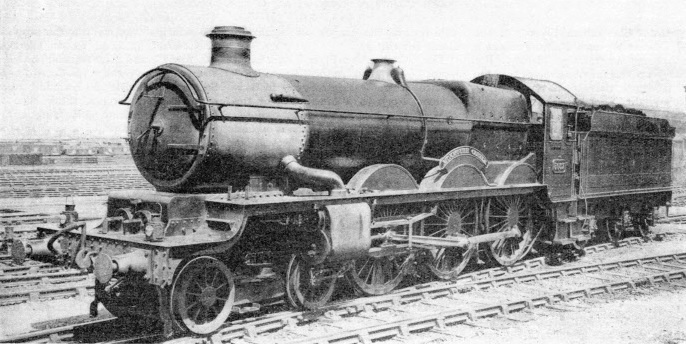
“MONMOUTH CASTLE”. One of the ten new “Castle” class engines constructed in 1935 at the Great Western Railway’s Swindon works. They were brought into service for the summer traffic. Locomotives of this class are generally used for the haulage of the “Cheltenham Flyer”, and are stationed for the purpose at Old Oak Common engine sheds. They work the 10.45 am from Paddington to Gloucester, and return with the “Flyer” - a round trip of 228 miles. A considerable variety of both engines and crews is used on this duty.
So near was this to the “seventy” line that the temptation to institute the first seventy-miles-an-hour booking on record became too strong to resist. In the summer of 1932, therefore, the schedule from Swindon to Paddington of the “Cheltenham Flyer” came down to 65 minutes, and the average start-to-stop speed rose to its present figure of 71.4 miles per hour. At the same time, the Cheltenham-London time was reduced to 2 hours 20 minutes, setting up a new standard of speed travel from this popular spa to London, and the arrival time in London, which had fluctuated between 4.55 and 5 pm, became finally fixed at the latter hour. The later five minutes is an advantage, for it enables the “Cheltenham Flyer” to keep clear of the “Cornish Riviera Limited”, due at 4.40 pm, if the latter is running a little behind time. The engine of the “Cheltenham Flyer” works through from Gloucester, though it is attached to Old Oak Common Shed, and so is manned by a London crew. It has gone down from Paddington to Gloucester on the 10.45 am train, and the Swindon London flight thus comes at the end of a round trip of 228 miles. But the down journey, with numerous stops, is no great tax on locomotive power. Some humour was once aroused along the line when the engine had been prepared at Old Oak for one of the exceptionally fast demonstration runs that have been made by the “Flyer” from time to time, and left Paddington on the leisurely 10.45 am down, bearing on the front of the smoke-box the announcement: “World’s Fastest Train”.
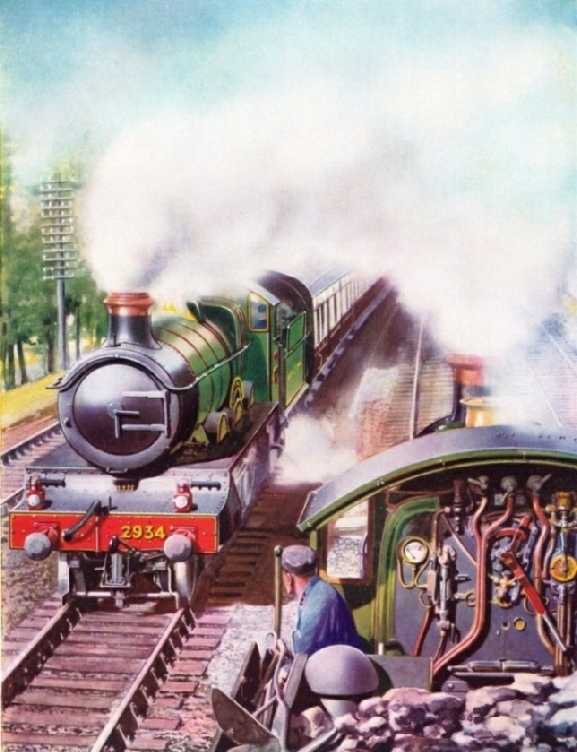
PASSING AT SPEED. An unusual view from the tender of a goods engine showing an approaching Great Western express between Reading and Didcot. The locomotive heading the express is of the “Saint” Class. The leading dimensions are: cylinders (two) 18½ in by 30 in; total heating surface, 2,104 sq ft; grate area 27.07 sq ft; diameter of coupled wheels, 6 ft 8½ in; working pressure, 225 lb; tractive effort, 24,395 lb; and weight of the engine, in working order, without tender, 72 tons.
[ Note: The “Saint” is No. 2934 “Butleigh Court”; whilst the colour plate was previously used on the cover of part 34.]
Almost invariably the engine employed is of the four-cylinder 4-6-0 “Castle” class. It may be wondered why a “King” is not found on this train; but, for sustained high speed with a moderate load, a “Castle” is undoubtedly the ideal engine. The “Kings” have been designed for the heavy trains and steep gradients of the West of England and Birmingham main lines, where their higher tractive power is developed to better advantage. No engine is exclusively allotted to the “Cheltenham Flyer” run, but a considerable variety of “Castles” and of engine-crews find their way on to this train, and competition is at times keen as to who can make the best speeds.
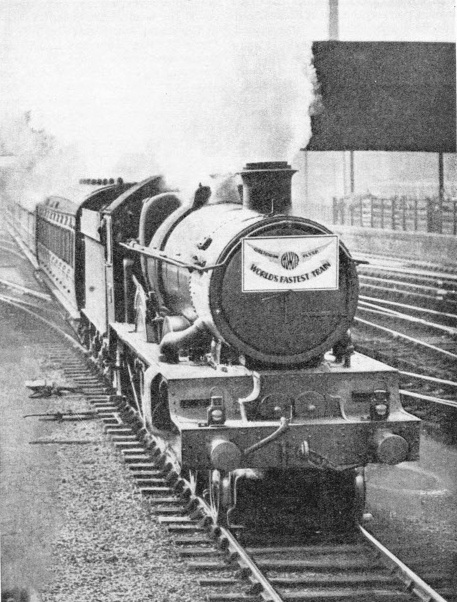 The first constituent of the train to get under way is the through coach from Hereford, which leaves that Cathedral City at 1.15 pm, and is brought along the Wye Valley through Ross to Gloucester by a “slow”, calling at all stations, and taking 70 minutes for the 30-miles run. At Gloucester this coach is attached to the rear of the restaurant car, which is waiting in readiness. Meanwhile, the “Cheltenham Flyer” proper, normally consisting of a third-class brake, a bogie third-class coach, two first- and third-class composites, and another third-class brake, has left the terminal St. James’ Station at Cheltenham at 2.40 pm.
The first constituent of the train to get under way is the through coach from Hereford, which leaves that Cathedral City at 1.15 pm, and is brought along the Wye Valley through Ross to Gloucester by a “slow”, calling at all stations, and taking 70 minutes for the 30-miles run. At Gloucester this coach is attached to the rear of the restaurant car, which is waiting in readiness. Meanwhile, the “Cheltenham Flyer” proper, normally consisting of a third-class brake, a bogie third-class coach, two first- and third-class composites, and another third-class brake, has left the terminal St. James’ Station at Cheltenham at 2.40 pm.
THE WORLD’S FASTEST STEAM TRAIN in regular service from 1932 until 1935 was the “Cheltenham Flyer”. This picture shows the celebrated express passing through Slough, Bucks, at speed. On a normal run the highest speeds - anything from eighty to eighty-five miles an hour - are generally reached near Steventon which is 56½ miles from Paddington, and at Slough, a distance of 18½ miles from Paddington.
Paradoxically enough, the train begins its journey in a direction which is exactly the opposite of that in which it really wishes to travel. This first stage is west-south-west, in the direction of Gloucester. The train stops at Malvern Road, Cheltenham, at 2.42 pm. At Lansdown Junction it passes on to the seven miles of line which are jointly owned by the Great Western and LMS Railways - a very busy section which forms part of the LMS West of England main line to Bath and Bristol. The Cheltenham section of the train runs into Gloucester Station at 2.53 pm. Here the engine that has brought the five coaches from Cheltenham is detached, and the restaurant car and Hereford coach are pushed on to what was the leading end of the train, but has now become the rear, for the direction of the train is here reversed, and it leaves the same end of the station as that by which it has entered. This is a geographical curiosity for momentarily the GWR train leaving Gloucester can meet, running in the opposite direction, an LMS express for the West of England, alongside which in the same direction, it may presently be running. At Gloucester, therefore, the London engine is attached to the “Cheltenham Flyer” and it leaves the station at 2.58 pm in a direction due east, changed in less than a mile to south-west as it passes round the triangle to resume its previous direction of running. The carriages bear head-boards inscribed “Cheltenham Spa Express”, for, curiously enough, the popular title of “Cheltenham Flyer” never appears in the time-tables and very seldom in any other official announcement. Normally, it consists of seven coaches, weighing 218 tons, but at week-ends and in the busy summer season it may be considerably heavier than this. Soon after leaving Gloucester, the LMS main line, from which the Cheltenham portion diverged at Engine Shed Junction, and which has since passed through the LMS station, appears from the west, and for some miles the two lines now run parallel and closely adjacent. The southbound “Devonian” express is due at just about this hour, and it is recorded that on more than one occasion there has been a race between the two expresses. Indeed, the LMS driver has been known to distinguish himself by beating the “Cheltenham Flyer” along this stretch. This is, however, a rare occurrence.
At Standish Junction this friendly rivalry comes to an end, for the Great Western line - which, incidentally, forms a part of Brunel’s original and very circuitous main line to South Wales, round the head of the Severn Estuary at Gloucester - turns eastward into the Cotswold Hills, while the LMS continues southwards. Over the latter, however, regular Great Western services run at various hours of the day. The Great Western Railway exercises “running powers” over LMS metals from Standish Junction - where there is a cross-over connection between the two pairs of tracks - to Yate, and uses this route for its express trains between Birmingham, Bristol and the West of England. So all the express services of both LMS and GW Companies from Birmingham to Bristol use the same lines from Lansdown Junction, Cheltenham, to Engine Shed Junction, Gloucester, and again from Standish Junction to Yate - twenty miles in all.
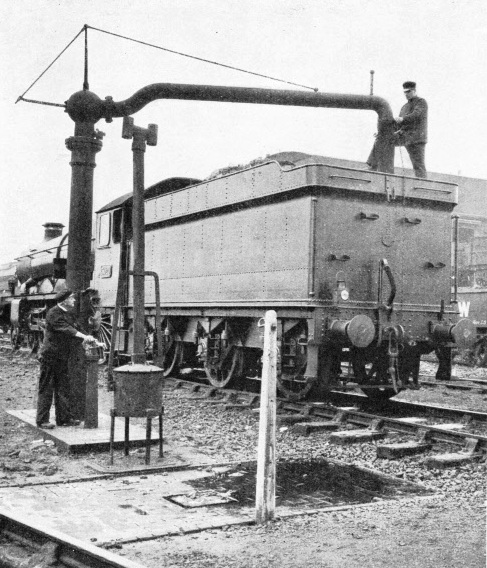
PREPARING FOR THE RUN. “Castle” engines are generally employed for hauling the “Cheltenham Flyer”. Here is the “Trematon Castle” taking water. The “Castle” engines were formerly equipped with tenders of 3,500 gallons capacity, but the latest tenders carry 4,500 gallons. These new tenders no longer bear the Great Western Railway coat-of-arms. The “Flyer” also picks up water from the track-troughs at Goring-on-Thames.
The valley through which the “Cheltenham Flyer” now runs is industrial and thickly populated. Stonehouse comes first; then Stroud, at which the train stops from 3.14 to 3.16 pm. and then Brimscombe. All these places are practically joined together. By Brimscombe, the valley, with its steep sides, has closed right in, and the railway now begins to climb. For three miles the gradient is as steep as 1 in 60 to 75, while the railway mounts higher and higher up the side of the valley through some fine wooded scenery. Finally, the line turns inwards at Frampton Crossing, and enters Sapperton Tunnel.
This bore is now shorter than it once was; in earlier days the centre portion of the tunnel collapsed, and was subsequently opened out into a cutting, so that the tunnel is now in two parts, with a stretch of daylight between. The longer section is 1,860 yards from portal to portal, and on a rising gradient of 1 in 90. At the summit of the ascent the train reaches Sapperton Sidings, and little but downhill or level now lies ahead all the way to London. A stop is made at Kemble from 3.33 to 3.35 pm where connection is made with the Cirencester and Tetbury branch trains, and from there a smart run is made over the 13¾ miles to Swindon in 16 minutes, start-to-stop, quite possibly with a maximum speed up to 75 miles an hour. Rounding the sharp curve through the locomotive works, the “Cheltenham Flyer” draws up at Swindon at 3.51 pm. Departure for London is timed at 3.55 pm.
Paddington is roughly 300 feet lower in level than Swindon, and the most pronounced of the modest gradients that make up this difference are found between Swindon and Didcot. From the start at Swindon the line falls at 1 in 834 to Shrivenham, and then at between 1 in 754 and 1 in 880 from there to Didcot.
The driver loses no time in attaining speed. By the time Shrivenham, 5.7 miles from Swindon, is passed - probably in about seven minutes or slightly less from the dead start - the train should normally be travelling at seventy-five miles an hour. The rate will then gradually increase past Uffington until the “eighty” mark is crossed somewhere in the region of Challow or Wantage Road. On many runs the speed will hover round, or generally slightly above, eighty miles an hour for the major part of the journey.
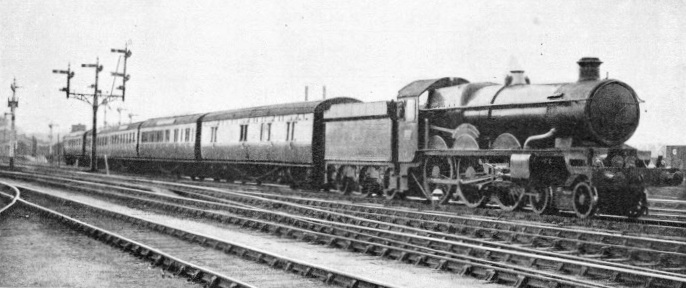
DEPARTURE FROM SWINDON. The “Cheltenham Flyer”, hauled by “Launceston Castle”, bound for London. The express is scheduled to cover the 77.3 miles to Paddington at an average speed of 71.4 miles an hour; it is only over this section of the journey that the trains travel at a very high speed. On a record run in 1932 the Swindon-Paddington stretch was accomplished at an average start-to-stop speed of 81.68 miles an hour.
But the best thrills are reserved for the days when the train has left Swindon late, and a driver who is keen on showing off the paces of his steed lengthens his cut-off a notch or two. Then the eighty mark gets left well behind, and the observer notes the speed gradually mounting until by Steventon it has reached eighty-seven, eighty-eight, or, on comparatively rare occasions, even the coveted ninety miles per hour maximum.
Very efficient locomotive work is needed to achieve and to maintain such high speeds with little or no assistance from gravity. It is not merely the matter of getting the steam into the cylinder with such lightning rapidity, but the even more important matter of getting it out again. This is where the wisdom of Swindon locomotive designing methods finds such striking proof. Long valve-travels and short cut-offs, which have been standard in Swindon practice for thirty years past, reduce back-pressure in the cylinders almost to vanishing point. This enables the engine to be worked with the regulator fully open, so that there is no throttling of the steam as it enters the steam pipe, and the expansive properties of its pressure may be used to the fullest advantage. No engines in existence in Great Britain run with more freedom at high speed than the Great Western “Castles”, and there are probably but few other express locomotive classes in Great Britain that could have maintained so consistent a time-keeping record on this service as the “Castles” have done.
The point-to-point timings of the “Cheltenham Flyer” from Steventon onwards demand average speeds in excess of eighty miles an hour. The fastest stretch is from Steventon to Slough, where thirty-eight miles are booked to be covered in twenty-eight and a half minutes, at an average of exactly eighty miles an hour throughout.
At Eighty Miles an Hour
From Didcot onwards the line flattens out, and the steepest grade subsequently is no more than 1 in 1,320, or four feet to the mile. Speed usually drops slightly between Goring, Pangbourne and Tilehurst, partly because of the resistance of taking water from Goring track-troughs, and partly from frictional resistance as the express negotiates the reverse curves bordering on the River Thames in the neighbourhood of Pangbourne. But only two or three miles an hour are dropped from the ruling speed; by Reading the train is travelling again at round about the eighty-miles-an-hour mark.
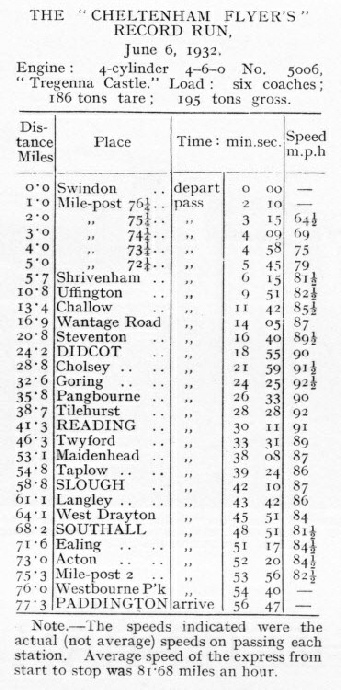 The value of the movable diamond crossings in the track is fully appreciated as the “Cheltenham Flyer” cuts through the intricate points and crossings at the west end of Reading Station, with not the slightest jolting or discomfort to passengers. Speed continues to rule high while running through Twyford and Maidenhead, and the slight descent, though no more than four feet to the mile, to Slough, may produce another maximum of anything from eighty-three to eighty-six miles an hour or so. On a normal run the highest speeds may be anticipated at Steventon and Slough.
The value of the movable diamond crossings in the track is fully appreciated as the “Cheltenham Flyer” cuts through the intricate points and crossings at the west end of Reading Station, with not the slightest jolting or discomfort to passengers. Speed continues to rule high while running through Twyford and Maidenhead, and the slight descent, though no more than four feet to the mile, to Slough, may produce another maximum of anything from eighty-three to eighty-six miles an hour or so. On a normal run the highest speeds may be anticipated at Steventon and Slough.
Speed may fall slightly below eighty miles an hour onwards through West Drayton and Hayes to Southall, but if the train is behind time, there will now be some slight acceleration, and given, as usually happens, a clear road, the driver will continue at full speed - probably at over eighty miles an hour again - through Ealing and Acton until he is approaching the great gasometers near Westbourne Park, where steam will be shut off. Brakes will be applied to reduce the speed to not more than fifty miles an hour through Westbourne Park Station, and more vigorously afterwards, but it is practicable to run the 1.3 miles from here to the dead stand in the terminus, with perfect safety and smoothness, in just over two minutes, if necessary, thus making possible a very smart stop. So the “Cheltenham Flyer” comes to rest at Paddington, and the chances are that the time of arrival is on the stroke of five o’clock.
The fastest recorded journey on the “Cheltenham Flyer”, up to the time of writing, was on June 6, 1932, when a special attempt was made to ascertain the minimum time in which the journey from Swindon to Paddington could be completed. The train consisted of six coaches, weighing 186 tons empty, and 195 tons with passengers and luggage, and was hauled by four-cylinder 4-6-0 No. 5006, “Tregenna Castle”. In the accompanying table will be seen the exact times from the start at which each station was passed, and the speeds at which the train ran from start to finish.
In two miles from the start “Tregenna Castle” was travelling at sixty-four and a-half miles an hour, four miles from starting the rate had increased to seventy-five; and somewhere about five and a quarter miles from Swindon the “eighty” line was first crossed - a remarkable exit. For seventy miles continuously the speed never fell below eighty miles an hour. From Shrivenham it continued gradually to increase until ninety miles an hour was reached at Didcot, and, finally, an absolute maximum of 92.3 miles an hour through Goring Station. For twenty eight miles continuously an average of ninety miles per hour was maintained. In these days, of course, ninety miles per hour is no longer an outstanding speed, but the point of this Great Western run was the maintenance of such tremendously fast travelling on level track, as compared with the falling gradients on which these other momentary feats of speed are usually achieved.
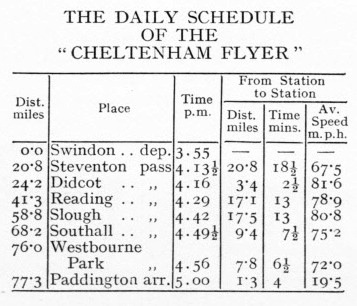 Two miles out of Paddington the train was still travelling at eighty-two and a-half miles an hour, steam was then shut off, and the train was brought smartly but smoothly to rest at Paddington fifty-six minutes forty-seven seconds after leaving Swindon, seventy-seven miles twenty-four chains away.
Two miles out of Paddington the train was still travelling at eighty-two and a-half miles an hour, steam was then shut off, and the train was brought smartly but smoothly to rest at Paddington fifty-six minutes forty-seven seconds after leaving Swindon, seventy-seven miles twenty-four chains away.
Over certain sections of the journey even quicker times have since been achieved, and on a number of occasions the run has been made in an hour, or slightly over, which proves that if the Great Western Railway decided to put a sixty-minute timing over the 77.3 miles from Swindon to Paddington, given a strict limitation of the maximum load of train to, say, seven or eight coaches, it could probably be observed regularly even with existing locomotives. As previously mentioned, such an acceleration would restore to the Great Western Railway the world steam supremacy.
Throughout, the “Cheltenham Flyer” has shown conclusively that ultra high-speed schedules are practicable, and may be maintained without any kind of risk where conditions of gradients, curvature, and so on, are suitable for very fast running. This famous express, as statistics have proved, is one of the most punctual running on the Great Western system, and it is seldom that any time is lost on the Swindon-Paddington section. Time has been kept by the “Castles” with loads up to ten and even eleven vehicles, weighing, loaded, from 350 to 400 tons, even though the schedule was originally designed for a six-coach train. But the popularity which calls for additional accommodation is yet another witness to the fact that “high speed pays”.
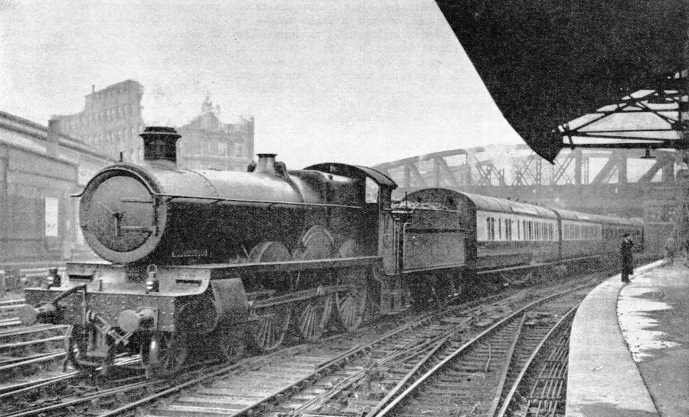
STARTING THE JOURNEY. The “Cheltenham Flyer” is the popular name for the “Cheltenham Spa Express”, which daily leaves Cheltenham for Paddington at 2.40 pm and covers the last stretch of the journey from Swindon at 71.4 miles an hour. Above is a photograph of a Cheltenham express outside Paddington Station.
You can read more on “The Bristol Two Hour Expresses”, “The Cornish Riviera Express” and “The Fishguard Boat Express” on this website.






 The first constituent of the train to get under way is the through coach from Hereford, which leaves that Cathedral City at 1.15 pm, and is brought along the Wye Valley through Ross to Gloucester by a “slow”, calling at all stations, and taking 70 minutes for the 30-
The first constituent of the train to get under way is the through coach from Hereford, which leaves that Cathedral City at 1.15 pm, and is brought along the Wye Valley through Ross to Gloucester by a “slow”, calling at all stations, and taking 70 minutes for the 30-

 The value of the movable diamond crossings in the track is fully appreciated as the “Cheltenham Flyer” cuts through the intricate points and crossings at the west end of Reading Station, with not the slightest jolting or discomfort to passengers. Speed continues to rule high while running through Twyford and Maidenhead, and the slight descent, though no more than four feet to the mile, to Slough, may produce another maximum of anything from eighty-
The value of the movable diamond crossings in the track is fully appreciated as the “Cheltenham Flyer” cuts through the intricate points and crossings at the west end of Reading Station, with not the slightest jolting or discomfort to passengers. Speed continues to rule high while running through Twyford and Maidenhead, and the slight descent, though no more than four feet to the mile, to Slough, may produce another maximum of anything from eighty- Two miles out of Paddington the train was still travelling at eighty-
Two miles out of Paddington the train was still travelling at eighty-